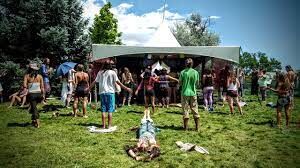Polyamory
The Second Wave of Consensual Nonmonogamy in the U.S.
CNM in the countercultures of the 1960s and 70s.
Posted April 27, 2022 Reviewed by Gary Drevitch
Key points
- The social setting in the United States during the 1960s and 70s set the stage for sexual revolution and challenges to gender norms.
- Swinging and group marriage were important forms of CNM during the second wave.
- Communes provided a group of like-minded people to share a collective vision and some focused on free love or polyamory.

This is the second post in a series that details the three waves of consensual nonmonogamies in the United States. The first identified the anarchist, feminist, and transcendentalist roots that shaped the first wave of CNM in mid-to-late 1800s in the Northeastern U.S. This pot details the second wave in the US, focusing on swinging, communes, and support groups in the 1960s and 70s.
Social Setting
In the United States, the 1960s and 70s proved to be a period of rapid social change, especially with significant changes in sexual and gender latitude. Second-wave feminists championed white women’s sexual issues like access to abortions and birth control as part of their larger bid for gender equity. Gays and lesbians challenged the supremacy of heterosexuality and exposed gender roles as socially constructed. Transgendered people similarly emphasized the performative and cognitive nature of gender. Bisexuals further destabilized the blend of gender and sexuality by minimizing the importance of their romantic partners’ genders.
Finally, social and economic conditions contributed to increasing autonomy for women and sexual minorities, especially white gays and lesbians. Industrialization, shrinking families, and the separation of sexuality from procreation enabled women to bear fewer children, and gays and lesbians to develop urban enclaves. Polyamory evolved as a direct result of the sexual revolution and combined with the bisexual and free-love movements. Like other aspects of polyamorous community, though, the history of the movement has some points of contention.
Group Marriage and Swinging
Research into group marriages and swinging peaked in the 1970s. By that time, the sexual revolution had popularized sexual experimentation, and the concepts of open and group marriages had gained notoriety. American culture was more sexually permissive than ever, and the specter of AIDS had not yet intruded on the playful sense of sexual experimentation. Those people involved in group marriages of three or more partners who all considered themselves married to each other and volunteered to participate in research tended to be mostly heterosexual or bisexual and white. It is highly likely that many other people also had multiple-partner relationships and just did not participate in research about them.
Research on swinging similarly flourished in the sexually adventurous 1960s and 1970s, documenting new trends in extramarital or co-marital sexual involvement Studies examined swingers’ race and ethnicity, social class, education, and political perspectives. This research created a profile of swingers as non-religious, White middle- and upper-middle class people in their late 30s.

Communes
The community movement, which had declined in the United States during the late nineteenth century, re-emerged in the form of communes in the 1960s and 70s. Similar to the transcendentalist communities of the 1860s and 70s, communes in the 1960s and 70s provided refuge from the disillusionment of the dominant culture and the hope for a more satisfying life with a group of similar people. Communes often emphasized the value of intimate relationships, personal growth, spiritual rebirth, return to nature, rebellion against the establishment, and cooperation over competition. Many communities included some form of atypical sexuality, from celibacy to free-love, though only a minority of contemporary communes endorsed sexually nonexclusive relationships.
Polyamorous Communes
Specifically polyamorous communes evolved in the late 1960s and early 1970s. Sandstone, an open love community that offered encounter groups and sex-positive discussions, was established by Barbara and John Williamson in Topanga Canyon just outside Los Angeles. Eminent counter-culturalists like Betty Dodson and Sally Binford frequented Sandstone shindigs.
Kerista, possibly the most influential non-monogamous, proto-polyamorous intentional community, was based in the San Francisco Bay area between 1971 and 1991. Composed of approximately 25 adults at any point, members of the Kerista community lived in separate group marriages or a single large group marriage. In addition to marriages, the Keristans shared everything — parenting, money, and personal growth processes.
Members owned and operated a computer sales business. During her tenure there, Ryam Nearing reported living in a community that attempted to provide emotional support for everyone. Nearing participated in seeking a Keristan vision which “started with twelve but later amped it up to twenty-four adults per family in their ideal – the goal they wanted to aim for” (Nearing, personal communication, 2003).
Support Groups
Informal and organized prototypical polyamorous support groups began to spread in the 1970s, the best known of which were Family Synergy in Los Angeles and Family Tree in Boston. Inspired by science-fiction writer Robert Heinlein’s Stranger in a Strange Land, Oberon and Morninglory Zell founded the Church of All Worlds and its related Ravenheart clan, still influential in the polyamorous movement today. Individuals started organizations focused on polyamory or polyfidelity, such as Nearing’s Polyfidelitous Educational Productions (PEP), a group in Denver called “Beyond Monogamy” that met regularly and published an edited volume, and Deborah Anapol’s IntiNet. Nearing and Anapol later teamed up to create Loving More magazine and nonprofit (which subsequently became Nearing’s solo project and has since transitioned through several editors) that published articles, poetry, and personal advertisements for, by, and about polyamorous people.
Swinging, group marriages, communes, and polyamorous communities all contributed to the burgeoning second wave of CNM in the United States in the 1960s and 70s. In the 1980s the sexual revolution collided with the spread of AIDS and other sexually transmitted infections, and the resulting backlash drove discussion of group sex and multiple partners out of mainstream society. Academic research on sexually non-exclusive relationships dwindled significantly during this period. Although very few such studies were published during the 1980s and 1990s, the practice of consensually non-monogamous relationships endured. Only a decade later, the first inklings of Internet communications began to spark new life in CNM communities in the U.S.
References
Anapol, D. M. (1992). Love without limits: the quest for sustainable intimate relationships: responsible nonmonogamy. Intinet Resource Center.
Bartell, G. D. (1970). Group sex among the mid‐Americans. Journal of Sex Research, 6(2), 113-130.
Jenks, R. J. (1998). Swinging: A review of the literature. Archives of sexual behavior, 27(5), 507-521.
Bartell, G. D. (1974). Group sex among the Mid-Americans. In Beyond Monogamy (pp. 185-201). The Johns Hopkins University Press, Baltimore.
Butler, J. (1988). Performative acts and gender constitution: An essay in phenomenology and feminist theory. Theatre journal, 40(4), 519-531.
Fang, B. (1976). Swinging: in retrospect. Journal of Sex Research, 12(3), 220-237.




